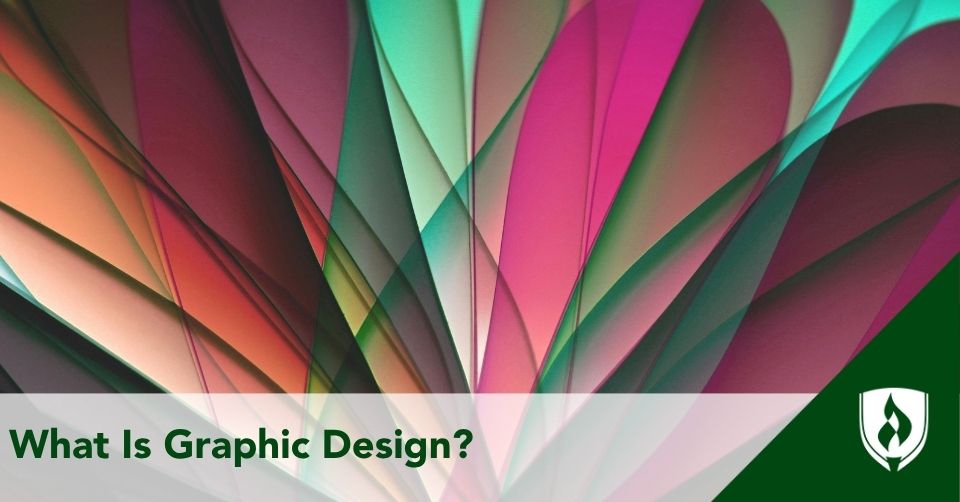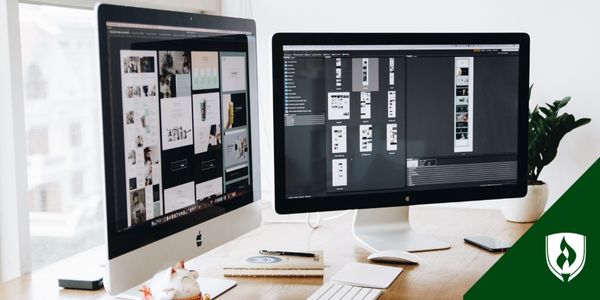What Is Graphic Design?
11/25/2025

If you’ve ever admired a memorable logo like Nike, a beautifully laid-out magazine like Vogue or National Geographic, or an eye-catching poster like “Got Milk”, you’ve experienced the work of graphic design — the process of turning ideas into visuals that communicate and connect.
In simple terms, graphic design is the art and practice of creating1 visual content to communicate ideas through imagery, color, typography, and layout. It’s both a creative and strategic discipline that combines aesthetics with problem-solving. Whether in print, digital media, or physical spaces, graphic design helps people make sense of information and connects audiences to messages that matter.
Graphic designers use2 a wide range of graphic design software, digital tools, and design principles to transform visual concepts into tangible, meaningful experiences. Every day, people interact with their work — from the layout of a website or magazine to a brand logo, poster, or package design.
Understanding Graphic Design and Visual Communication
At its core, graphic and visual design focuses on visual communication, the ability to share information in ways that are clear, consistent, and visually appealing.3 Through the careful use of design elements such as line, color, texture, space, and typography, graphic designers create compositions that not only look good but also guide understanding and evoke emotion.
Digital design plays an essential role in how people interact with brands, technology, and information. From marketing materials and advertising graphic design to websites, signage, and social media visuals, design is part of nearly every visual experience we have.
What’s the Difference Between Graphic Design and User Experience (UX) Design?
While both graphic design and UX design rely on visual elements such as color, typography, and layout, their goals and methods differ.1 Graphic design focuses on creating visually appealing compositions that communicate messages clearly and effectively. It often involves developing brand identities, print materials, and digital assets that establish a consistent look and feel. Graphic designers prioritize aesthetics and visual storytelling, using imagery and design principles to convey meaning and evoke emotion.
UX design, on the other hand, centers1 on how people interact with a product or system. It goes beyond visuals to consider usability, accessibility, and the overall flow of a user’s experience. UX designers use research, prototyping, and testing to ensure that digital interfaces are intuitive and functional. While graphic design creates the visual language, UX design shapes how that language is experienced — blending art and logic to make digital interactions seamless and meaningful.
Key Elements and Principles of Graphic Design
The foundation of any strong design lies in understanding the key elements that guide composition and message clarity. Graphic design elements serve as the building blocks for every design project, and they are used in both print media and digital spaces.
Some of the most important design elements include:1
- Line: Defines form, creates movement, and leads the eye.
- Color: Enhances mood, emotion, and tone; guided by color theory.
- Shape: Creates structure and helps define relationships between elements and establish visual hierarchy.
- Texture: Adds visual depth and tactile interest.
- Space and Negative Space: Give the design breathing room and emphasize focal points.
- Typography: Shapes how language is seen and felt, influencing readability.
- Harmony: Establishes a cohesive identity so that all the elements in a design have similar components to help people understand the message.
- Balance: Distributes the visual weight in a design that creates stability, achieved through symmetry or through varied elements like size, color, and texture.
Understanding these principles allows designers to create compositions that are both functional and visually appealing.
The creative process behind each project combines exploration, testing, and refinement. Experienced graphic designers often start with user research, brainstorming, and sketching before moving to digital design software to bring ideas to life.
The Design Process: From Concept to Creation
Whether working on print media, a website, or packaging graphic design, the design process typically follows several key stages:4
- Communication: Have a thorough conversation with the client about their goals, needs, a deadline, scope and how the project will be handled, i.e. staging and compensation.
- Research and Discovery: Understanding the audience, context, and goals of the project.
- Concept Development: Generating ideas and visual concepts that align with the message.
- Creating Layouts: Experimenting with structure, negative space, and hierarchy.
- Refinement and Feedback: Revising the design based on critique and collaboration.
- Production: Finalizing and delivering the visual assets for print or digital use.
This process reflects both creativity and critical thinking. While graphic artists and art directors may lead overall direction, graphic designers work collaboratively across disciplines — often with web designers, writers, and UX designers — to ensure that every design project communicates clearly and functions effectively.
Common Types of Graphic Design
The types of graphic design are diverse, reflecting the many ways visuals can inform and inspire. Each specialization1 requires unique technical and specialized capabilities tailored to its medium and purpose.
Visual Identity Design
This area focuses on brand identity, including logo design, color palettes, and visual systems that help organizations communicate their personality and values. Visual identity work ensures consistency across marketing materials, digital platforms, and print media.
Marketing and Advertising Graphic Design
Advertising graphic design is about crafting visuals that capture attention and deliver messages effectively. These designs often appear in campaigns, posters, social media, and digital ads. Designers balance creativity with communication, ensuring that visuals align with the overall marketing strategy.
Publication Graphic Design
Found in books, magazines, and digital publishing, publication graphic design involves creating layouts that organize text and imagery in a way that’s engaging and readable. This type of work requires a strong understanding of composition and typography.
Packaging Graphic Design
In packaging graphic design, designers create designs that both protect and promote products. They consider materials, form, and labeling to ensure that packaging stands out on shelves and conveys the right message.
Illustration Graphic Design
Designers use hand-drawn work and digital software to create a visual story. It’s common to see characters, scenery, location-specific illustrations to add personality to a product, website, social media graphic or book.
Skills and Tools in Modern Graphic Design
Graphic design focuses on merging creativity with technology. Graphic designers may use a broad range of graphic design skills,2 from photo editing and typography to motion graphics and coding for web environments.
Common Tools and Software Programs
Modern graphic designers work with a variety of design software5 and digital tools,1 including:
- Adobe® Illustrator®: For vector-based artwork and logos.
- Adobe® Photoshop®: For photo editing and digital illustration.
- Adobe® InDesign®: For creating layouts and digital publishing projects.
- Figma®: For UX design and user interfaces.
These tools allow graphic designers to create designs that are scalable, interactive, and adaptable across multiple formats.
Developing Technical and Creative Skills
Beyond tools, graphic design relies on strong technical skills1 and a deep understanding of design principles. The ability to create art, analyze feedback, and iterate is vital.
For students, pursuing a degree6 in graphic design or fine arts may help them learn foundational knowledge in color theory, composition, and the historical context of visual culture. A graphic design degree may also encourage skills like critical thinking and collaboration — essential parts of the creative process.
Pursuing a Graphic Design Education
Pursuing a career in graphic design begins with a desire to explore how visuals shape perception and meaning. Students studying6 design may also be interested in the fine arts, photography, communications, or technology.
A graphic design degree6 may help students prepare to learn design principles, software, and conceptual development. Courses often include hands-on projects, critiques, and collaborative assignments that mirror real-world design challenges.
Throughout their education, students may explore both creative and technical skills that may help them to gain confidence in the design process and the ability to create designs across mediums. Many programs6 encourage experimentation, allowing students to explore interests like logo design, motion graphics, packaging graphic design, or UX design.
Seeing Ideas Come to Life
Graphic design is a dynamic and multifaceted field that merges art, technology, and communication. It asks essential questions: How can visuals help people understand ideas? How can design make experiences more meaningful?
Through a blend of creativity, strategy, and technical skills, graphic designers work to create visual content that informs, inspires, and connects. Whether developing a visual identity, designing for digital publishing, or exploring environmental graphic design, the field continues to evolve with new tools and cultural insights.
For anyone drawn to creativity, collaboration, and communication, exploring what you can do with a graphic design degree may inspire learners to pursue creative opportunities that blend artistic vision with the ever-changing possibilities of the digital age.
Adobe®, Adobe® Illustrator®, Adobe® Photoshop®, and Adobe® InDesign® are registered trademarks of Adobe® Inc.
Figma® is a registered trademark of FIGMA, INC. (CORPORATION; DELAWARE, USA).
1 “What Is Graphic Design? | Resource Library,” Figma®, at https://www.figma.com/resource-library/what-is-graphic-design/ (accessed October 31, 2025).
2 Bureau of Labor Statistics, U.S. Department of Labor, Occupational Outlook Handbook, Graphic Designers, at https://www.bls.gov/ooh/arts-and-design/graphic-designers.htm#tab-2 (accessed October 31, 2025). Employment conditions may vary.
3 Adobe®, “Visual communication examples,” at https://www.adobe.com/uk/express/discover/examples/visual-communication (accessed October 31, 2025).
4 Design Dojo, “Design Process,” at https://www.designdojo.org/design-process (accessed October 31, 2025).
5 CRM.org, “Best Graphic Design Software,” at https://crm.org/news/best-graphic-design-software (accessed October 31, 2025).
6 Rasmussen University, “Bachelor’s in Graphic Design,” at https://www.rasmussen.edu/degrees/design/graphic-design/bachelors/ (accessed October 31, 2025).



